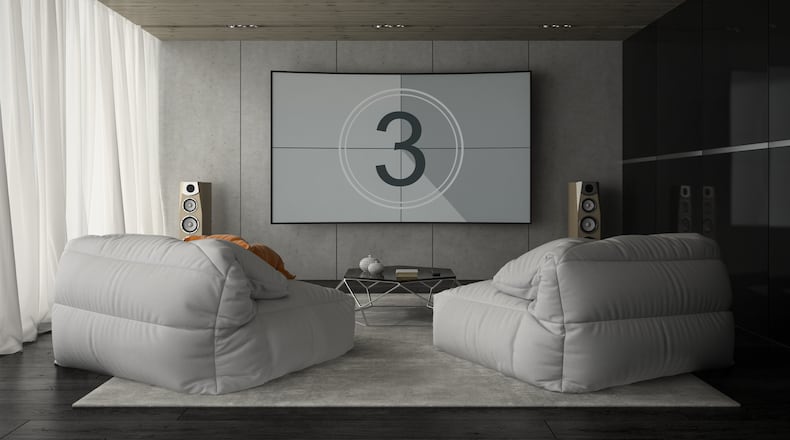Choose the right space
The first step is to decide where to set up your home theater. The area will be how you determine which speakers are best, the optimal screen size and how many people will comfortably fit in the space. It will also determine what remodeling, if any, is needed.
Common pitfalls
One of the worst parts of going to a traditional theater is the sticky floors. This is one part of the experience that you don’t want to have at home. While it’s not possible to prevent all spills, you can make cleanup easy.
Install waterproof hard flooring in your home theater so that any messes can be quickly swept or mopped up. Also, use movable seating so that every part of the floor can easily be reached with standard cleaning tools.
Selecting the sound system
It goes without saying that a home theater needs surround sound, or an equivalent. Those using a repurposed bedroom or home office may need fewer speakers than if they are setting up a theater in a large living room. Smaller rooms can also use less powerful speakers since the sound doesn’t have to travel as far.
In either case, choose high-quality speakers. Select a well-established, high-end brand such as Bose if the budget allows. Make sure it is enabled with Dolby Atmos or a similar system so that all of the sounds come from the right places.
Choose a proper screen
As with the sound system, the size of the room determines the optimal screen size. Resist the urge to get the biggest possible screen just because commercial theaters do it. Some people get headaches when they have to sit in the front rows of a movie house because the big screen is too big for watching from such a close distance.
For a home theater, choose a size that will be comfortable to watch from the primary sitting location.
Credit: Getty Images/iStockphoto
Credit: Getty Images/iStockphoto
Chances are good that you the experience won’t limited to watching movies, so select a high-end television to watch shows of all sorts, or go for a big monitor if there will be video game playing or computer use.
If the space allows, consider a roll-down projection screen with a projector hanging in the middle of the room.
Package deal, or mix-and-match?
Proponents of package deals will say all of the components are engineered to work together, that package deals save people from having to hunt down components — and that setup is easier. Meanwhile, mix-and-match fans will point out that a great speaker company may not be the best source of TVs or other equipment.
They will say that it’s better to get the highest rated option for every component, whether it’s all from the same company or not. Use whichever method most suits the style.
Credit: Getty Images
Credit: Getty Images
Accessorize
Add some fun stuff: Items such as popcorn machines, soda fridges and candy dispensers are what make a home setup a theater instead of a mere viewing room. Like everything else that is chosen for a theater, designers of the space can get options ranging from basic and budget friendly to things that are high-end.
For example, a table-top popcorn machine may cost around $200, while one with a kettle card might be upward of $2,000.
GET CREATIVE
Here are some items you might consider adding to a cinema room:
- A bar at the back of the room, ideal for watching sports events on the big screen
- Golf putt-putt green in front of the screen
- Large bean bags or plush floor seating in front of a row of couches or recliners
- Blackout curtains or blinds if the room has windows
- A digital fireplace for added ambiance somewhere in the space
- Shelves on the walls that display fun movie-themed decor such as framed posters or items from a home goods store
- Side tables at the end of each row
- Plugs for charging phones
- Chalkboard to scribble menus if hosting parties int he space
- Mini-fridge
- Remote control holders
- Baskets with blankets and pillows to get comfortable
About the Author



